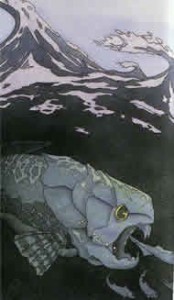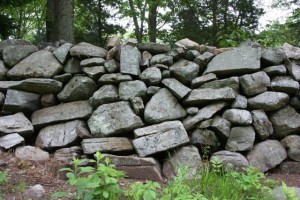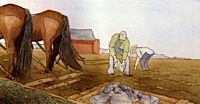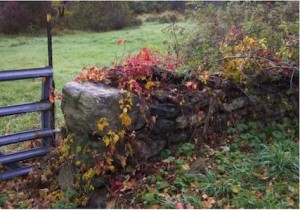
WHAT GRAMPA DIDN’T TELL YOU
In the very last scene of Stone Wall Secrets, Adam reads the stonemason’s letter, folds it thoughtfully, and then pushes it deep into his pocket. Only several hours earlier he had been joyously riding his bicycle, innocent of the dilemma he was about to face.
Between these two scenes, Adam’s worldview had been transformed. He now understands that their New England family farm was a place where human history merges seamlessly backwards into natural history. He also understands that their “… small corner of the earth…” is a place where past and future environmental choices — including the seemingly benign one he is about to make — always involve a tradeoff between short-term monetary benefits and more lasting, intangible ones. Our beginning and ending scenes with the stonemason’s letter also signify the transfer of knowledge and decision-making authority from one generation to the other, in this case, from a biological family to one formed by adoption. How could a child’s world-view be transformed so significantly in so little time?
The answer is that Grampa — the archetype teacher — had planned this learning opportunity well. Their pleasant afternoon sojourn, although ostensibly about repairing stone walls, was actually a carefully scripted outdoor lesson targeted at a child of just the right age. Grampa’s strategy was to physically guide the boy along a path where accidental discoveries would present themselves; to ask gently probing, open-ended questions about each discovery; to confirm and reinforce the boy’s tentative answers with solid facts; and most importantly, to help launch the boy’s imagination into ancient worlds that are just as real as those of today. In other words, Grampa was teaching the boy to wonder, as well as to learn.
As you — the grandparent, parent, mentor, librarian, camp counselor, teacher or administrator — begin to think of ways to incorporate Stone Wall Secrets into your own learning opportunities, you might wish that you also had Grampa’s wisdom and expertise on these subjects. Don’t despair. Consider that he is right here with you, sharing what he knows not in words, but with this easy-to-use reference. So, who is Grampa, anyway? To begin with, Grampa is a scientist who understands how New England was stitched together geologically and how the farmÕs combination of rocks, soils, and climate work together as an integrated physical system of hills, valleys, ponds, and streams; his view of the landscape is that of a skilled, and disciplined observer, one in full possession of the facts at hand. Grampa is also a teacher who knows how to entice children into learning situations, and when to strike them with just the right question; his view of his grandson is that of an eager “sponge” ready to absorb the important lessons of life, but needing help along the way. Finally, Grampa is a sensitive person who understands that important lessons must be experienced emotionally; his view of the world is one in which all humans, all animals, all physical processes, and all academic disciplines are unified by their common origin at the beginning of earth history.
Essentially, Grampa is a wise man. During each of his quasi-mystical encounters with the earth, he combines his analytical skills with a reservoir of knowledge to conjure an image so powerful that it seems to transcend reality. Like the “medicine woman” pictured in our Native American section, Grampa is able to “sense” something about deep time and earthly drama that lies just beyond the limit of our intellectual comprehension. His wisdom also extends to the human relationships involving family life in the late 20th century, those required to build trust between different generations, races, and religious traditions. In the final analysis, Grampa’s narrative is the story of the bonds that tie us all to each other, and to the earth itself.
TEACHING ACROSS THE CURRICULUM

You, the leader of children, must now take over where Grampa left off. Based on your own area of expertise — be it literature, art, social studies, or science — you are likely to begin using Stone Wall Secrets by selecting and emphasizing those content areas that you personally know best. If you are working with a team of teachers, each of you will do the same. Teacher’s Reference Manual for Stone Wall Secrets is designed to even out these differences in expertise regarding the archaeological significance of stone walls, their place in American history and literature, and the more technical aspects of geology, forestry, soils, climate, and planetary science. We also explain the pedagogical and literary devices we used in writing our book, ones that could be easily adapted for other activities as well. Finally, we identify and clarify places in the text where contemporary societal values are implicit to the story. Essentially, this reference will help you unify subjects normally taught separately, either in your classroom, or throughout the building.
This is not a teacher’s guide. A fine one already exists, written by Ruth Deike, a retired geologist who we imagine as the female counterpart for Grampa. Hence, we offer no new classroom activities, no learning objectives, and no identified curriculum standards. Rather, our purpose is to provide an inexpensive, easy-to-read, convenient reference to accompany the original text, one that could be used in a variety of formal, and informal settings, and one that neither duplicates, nor depends upon the teacher’s guide.
USING THIS REFERENCE

This document consists primarily of 171 text annotations written to enhance and explain the text. Each annotation consists of a number in brackets that refers specifically to the underlined phrase preceding it. Each annotation number is followed by three indexing elements. First is a subject category. These are the ones we came up with.
- ARCHAEOLOGY: Prehistoric human lifeways in the northeast.
- EARTH SCIENCE: Geology, climate, soils, & planetary science.
- ENVIRONMENT: Ecological changes and contemporary environmental choices.
- HISTORY: A few relevant details of American History.
- LITERATURE: Literary devices used and links to American Literature.
- SOCIETY: Family generations, gender, and immigration values.
- STONE WALLS: The regional phenomenon. When? Why? How?
- TEACHING: Pedagogical techniques and the learning process.
Following each subject category we also provide one or more key words that describe the content of the note, and which are designed to help you locate, then focus on specific bits of information. After the key words for each annotation, we include one or more sample questions that are answered in the note below. These five indexing differelements: Index number, Subject category, Key words, Question, and Text of note allow this reference to be used in a variety of ways.
Subject Index. If you wish to “bone up” on any of the eight categories of subjects covered, simply locate those annotations dealing with that subject and read them. If you are searching for specific definitions, facts, or explanations, scan the list of key words for each subject, then locate the note and read it.
Annotations . This section contains 171 notes indexed to the original text of Stone Wall Secrets. This part is designed for those who, as they read the text, want to know more about any particular aspect. Information about each of the underlined phrases can be found in the note below the block of the original text, identified by its black font. The location with the original text of the set of notes is indicated by giving each page a name. It also contains notes on the illustrations: pointers to technical details regarding the objects, landforms, and animals in each of Gus Moore’s paintings. To use this part, simply locate the appropriate illustration, then look for the details we point out.
More About Stone Walls. This section contains a list of facts about stone walls, a list of reference books on the subject, and a list of poems by Robert Frost that can be used with the text. Finally, this document is organized to follow the sequence of pages in the original book. Since there are no page numbers, each page is given a title that describes the illustration on that page.
